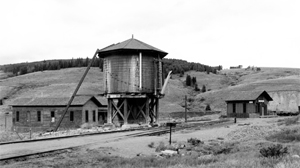National and State Register
Denver & Rio Grande Western Railroad San Juan Extension (Cumbres & Toltec Scenic Railroad)
Conejos County
This nationally significant narrow-gauge railroad segment exists as one of only two operating sections of what was once a state wide network of three foot gauge tracks built and operated by the Denver and Rio Grande Railroad.

Denver & Rio Grande Western Railroad San Juan Extension (Cumbres & Toltec Scenic Railroad) (2005 photograph.)
Also known as the Cumbres & Toltec Scenic Railroad, the Denver & Rio Grande (DR&G) Railroad San Juan Extension was placed in the National Register of Historic Places in 1973 with additional documentation approved in 2007. The National Historic Landmark designation recognizes the railroad’s significance between 1879 and 1929, beginning with construction of this segment to when its modernization ceased. The Denver & Rio Grande Western Railroad, successor to the D&RG, did not substantially change operational or maintenance practices after 1929.
The 64-mile route straddles the Colorado-New Mexico border on the western edge of the San Luis Valley and is an outstanding representation of the larger 1,000-mile network that opened the central Rocky Mountain region for development. The right-of-way includes narrow gauge track in its original alignment, depots, water tanks, trestles, telegraphone booths, section houses, tunnels, livestock loading pens, ten steam locomotives, and over a hundred other pieces of rolling stock.
The so-called Narrow Gauge Movement of the late nineteenth century was one of the most distinctive epochs in American railroading. The network defined by the Denver &Rio Grande, its affiliated companies, and especially the San Juan Extension represented an ambitious, extensive, and successful expression of narrow gauge (36") railroading as a viable alternative to the prevailing system of standard gauge (52 ½") track. The segment served as a de facto narrow gauge "proof of concept" project demonstrating the ability of 36" railroads to penetrate mountainous regions, operate over long distances, and scale equipment and infrastructure to meet heavy traffic demand.
The property is associated with the Railroads in Colorado, 1858-1948 Multiple Property Submission. This site continues into Archuleta County.
